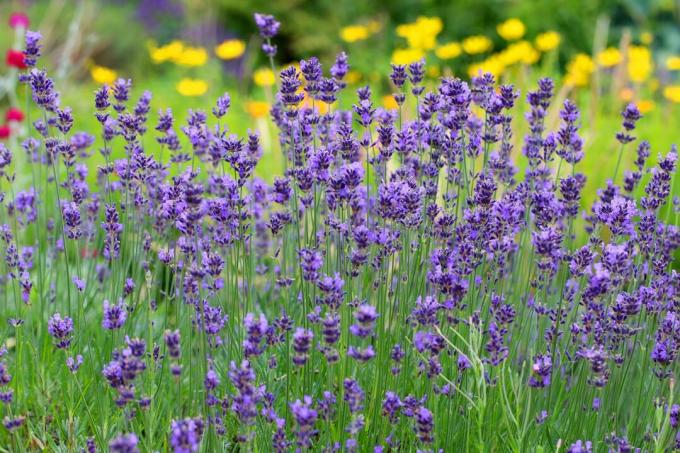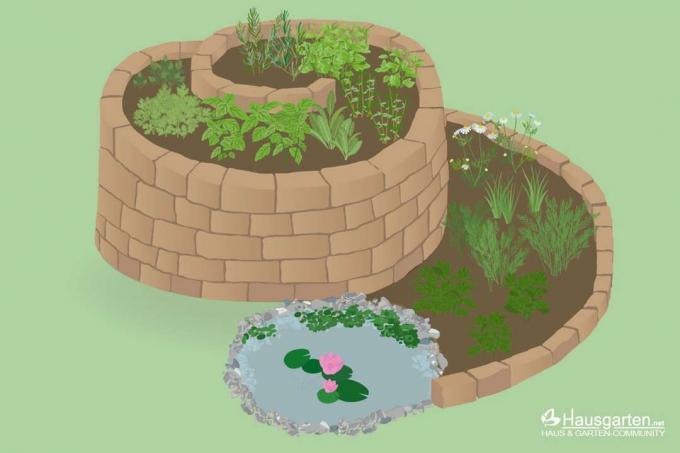

Table of contents
- Edible or not?
- The taste
- forms of use
- how to harvest
- How to make durable?
When the rosemary blooms, it fascinates with its colors and becomes an eye-catcher in pots and borders.
Edible or not?
Many other spice and edible plants become intolerable or at least inedible when flowering begins. However, this is not the case with Rosmarinus officinalis. But on the contrary. In addition to the widespread use of the needles - be it fresh as a twig, dried or ground - the individual flowers can also be consumed without hesitation.
The taste
The aroma of rosemary flowers resembles that of the more widely known needles. However, it turns out to be much more reserved and fine, since the flowers lack the strong and distinctive resin of the leaves. The aroma of the rosemary blossoms quickly disappears, especially in connection with dishes with an intense taste of their own. Therefore, its use is neither well known nor widespread.
forms of use
Used in the right context, rosemary blossoms also help to create a fine and restrained rosemary aroma. Since this evaporates quickly when cooking, other forms of use for the flowers have prevailed:
- By adding it to coarse table salt as rosemary salt
- Pure and fresh as an edible decoration on cheese platters, desserts, etc.
- As a fine touch in salads

how to harvest
The easiest way to harvest rosemary blossoms is to remove them together with the associated rosemary sprig. Especially if you want to use both anyway, the branch can simply be broken off or cut and later separated into blossoms and needles in the kitchen. Alternatively, you can carefully twist off the individual blossoms directly on the bush and continue using them without damaging the branch.
Tip:
As is well known, the eye eats with you. So why shouldn't hearty rosemary dishes prepared with the sprigs also be decorated with a delicate purple rosemary blossom?
How to make durable?
In contrast to the rosemary needles, the flowers are very delicate and fall apart quite quickly. Normal drying in a dry and warm place therefore usually leads to unsatisfactory results. Therefore, support drying in a controlled manner in order to continue to obtain attractive and at the same time durable flowers:
- Line the baking sheet with parchment paper
- Distribute the flowers individually on the baking sheet
- Dry the blossoms in the oven at 30 degrees Celsius for around 30 to 45 minutes with top and bottom heat
- Leave flowers to cool and store in a dark and airtight place
DANGER:
The small blooms are slightly swirled by a convection oven and spread off the baking sheet. Therefore, choose top and bottom heat without the air movements of the convection setting. Due to the low humidity from the flowers, the removal takes place to a sufficient extent even without air movement.
 Home editorial office
Home editorial office
Learn more about growing herbs

Basil has black dots: what to do?
Especially basil bought in a pot from the supermarket tends to quickly develop black dots or spots on the leaves. This article explains why this is and what helps against it.

14 kitchen herbs that you can really keep in the kitchen
Sometimes a herb garden is only possible on the windowsill. If you don't have your own garden bed, for example, or in the months when the frost freezes the coveted greenery outside. Our list provides an overview of which herbs like the kitchen location permanently.

Parsley turns yellow: Four tips against yellow leaves
If the leaves of the parsley suddenly turn yellow, the so-called parsley disease is usually behind it. This can have many causes. If the outbreak of the disease is to be prevented, only prevention helps. More about this here.

You can combine lavender with these 13 plants
Whether you use it in the kitchen, want to enjoy its fragrance or its beauty, lavender is a must in any garden. Well combined, it can strengthen other plants or protect them from pests. We present the best plant neighbors.

8 tips for cutting and harvesting herbs properly
Fresh herbs from the garden should not be missing in any kitchen. They are versatile, exude pleasant and spicy scents and are a treat for the eye with their pretty flowers. In the kitchen, they can easily replace artificial flavor enhancers.

Herb spiral & herb snail: this is how it's done
A herb spiral or herb snail makes it possible to plant many different varieties in a particularly decorative way. However, this is not the only advantage of these variants of the culture. You can find out how to create them here.



